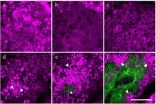(Press-News.org) Wrinkles, dryness, and a translucent and fragile appearance are hallmarks of old skin, caused by the natural aging of skin cells. But while most of us can recognize the signs of lost youth when we peer into the mirror each morning, scientists do not have a standardized way to measure the extent of age damage in skin. Now a group of Taiwanese researchers has used a specialized microscope to peer harmlessly beneath the skin surface to measure natural age-related changes in the sizes of skin cells. The results, which are published in the Optical Society's (OSA) open-access journal Biomedical Optics Express, can be used to study the general phenomenon of skin aging and may help provide an index for measuring the effectiveness of 'anti-aging' skin products.
In the study, Chi-Kuang Sun, a distinguished professor at National Taiwan University and chief director of the university's Molecular Imaging Center, along with medical researcher and dermatologist Yi-Hua Liao and colleagues, evaluated 52 subjects ranging in age from 19 to 79 years old. The researchers focused a brief burst of infrared laser light into the skin of the subjects' inner forearms, an area that is generally protected from sun damage, which accelerates natural aging. The beam penetrated to a depth of about 300 millionths of a meter, or approximately where the epidermis (the upper layer of skin) and the dermis (the lower layer) meet.
The researchers used a technique known as harmonic generation microscopy (HGM), which has previously been used to study developing embryos. In the procedure, a concentrated beam of photons is sent into a material. The photons naturally oscillate at a particular frequency, and as they interact with the material, they generate "harmonics" – vibrations that are multiples of the original frequency, which are characteristic of the material structure and properties. For example, the second harmonic is twice the original frequency and the third harmonic is three times the original frequency. In an imaging system, harmonics can reveal different structures at very high resolution. In their study, the team scanned for reflected second and third harmonic photons, and from those measurements, produced a high-resolution 3-D map of the tissue that revealed structures within the skin cells.
Natural aging, the scanning showed, caused a significant increase in the overall size of cells known as basal keratinocytes – the most common cells in the outermost layer of skin – as well as in the sizes of their nuclei. However, other types of skin cells, known as granular cells, did not show a similar pattern. Thus, says Sun, the relative changes in the two types of cells can serve as an index for scoring natural or "intrinsic" skin aging –the aging of skin caused by programmed developmental or genetic factors.
"No one has ever seen through a person's skin to determine his or her age from their skin," says Sun. "Our finding serves as a potential index for skin age."
A skin age index would provide a standardized, quantitative scale that could be used rate the true "age" of skin, from young (less age-related damage) to old (more age-related damage). The scale could give doctors another tool to monitor the overall health of skin—by investigating whether the skin of certain individuals or populations ages faster or slower than average, tracking the aging of an individual's skin over time, or testing how effective anti-aging treatments are at slowing the rate of skin aging.
Intrinsic, or chronological, aging is different from extrinsic aging, which is caused primarily by sun exposure. "There are a lot of extrinsic factors that can accelerate the aging process, such as smoking, ultraviolet light, and stress," says Sun. The researchers found that the extent of extrinsic skin aging in their study subjects varied depending on occupation, personal habits, and skin type, but because the researchers looked at skin on the sun-protected inner forearm, their findings provide a measure of the primarily genetically-based intrinsic skin aging.
"This could provide an index for someone who cares about the health of their skin and might also provide a test-bed for measuring the effectiveness of 'anti-aging' skin products," Sun says. "Of course," he and Liao joke, "you could set an HGM scanner at the entrance to a bar, so you can know whether a person is over 21 years old and permitted for entry."
INFORMATION:
Paper: "Determination of chronological aging parameters in epidermal keratinocytes by in vivo harmonic generation microscopy," Biomedical Optics Express, Vol. 4, Issue 1, pp. 77-88 (2012).
EDITOR'S NOTE: High-resolution images are available to members of the media upon request. Contact Angela Stark.
About Biomedical Optics Express
Biomedical Optics Express is OSA's principal outlet for serving the biomedical optics community with rapid, open-access, peer-reviewed papers related to optics, photonics and imaging in the life sciences. The journal scope encompasses theoretical modeling and simulations, technology development, and biomedical studies and clinical applications. It is published by the Optical Society and edited by Joseph A. Izatt of Duke University. Biomedical Optics Express is an open-access journal and is available at no cost to readers online at www.OpticsInfoBase.org/BOE.
About OSA
Uniting more than 180,000 professionals from 175 countries, the Optical Society (OSA) brings together the global optics community through its programs and initiatives. Since 1916 OSA has worked to advance the common interests of the field, providing educational resources to the scientists, engineers and business leaders who work in the field by promoting the science of light and the advanced technologies made possible by optics and photonics. OSA publications, events, technical groups and programs foster optics knowledge and scientific collaboration among all those with an interest in optics and photonics. For more information, visit www.osa.org.
No more lying about your age: Scientists can now gauge skin’s true age with new laser technique
New skin age index could provide test-bed for measuring effectiveness of 'anti-aging' skin products
2012-12-13
ELSE PRESS RELEASES FROM THIS DATE:
12 matter particles suffice in nature
2012-12-13
This press release is available in German.
How many matter particles exist in nature? Particle physicists have been dealing with this question for a long time. The 12 matter particles contained in the standard model of particle physics? Or are there further particles with too high a mass to be produced by the experiments performed so far? These questions are now answered by researchers of KIT, CERN, and Humboldt University in the current issue of the Physical Review Letters. (DOI: 10.1103/PhysRevLett.109.241802)
Matter particles, also called fermions, are the elementary ...
Study sheds light on how cells transport materials along crowded intercellular 'highways'
2012-12-13
Worcester, Mass. – The interior of an animal cell is like a small city, with factories—called organelles—dedicated to manufacturing, energy production, waste processing, and other life functions. A network of intercellular "highways," called microtubules, enables bio-molecular complexes, products, and other cargo to move speedily about the cell to keep this vital machinery humming. A new paper published online in the journal Proceedings of the National Academy of Sciences sheds new light on how cells manage to keep traffic flowing smoothly along this busy transportation ...
Your Christmas tree and its genome have remained very much the same over the last 100 million years
2012-12-13
This press release is available in French.
Quebec City, December 13, 2012—A study published by Université Laval researchers and their colleagues from the Canadian Forest Service reveals that the genome of conifers such as spruce, pine, and fir has remained very much the same for over 100 million years. This remarkable genomic stability explains the resemblance between today's conifers and fossils dating back to the days when dinosaurs roamed the Earth. Details of this finding are presented in a recent issue of the journal BMC Biology.
The team supervised by Professor ...
OU study suggests the bacterial ecology that lives on humans has changed in the last 100 years
2012-12-13
A University of Oklahoma-led study has demonstrated that ancient DNA can be used to understand ancient human microbiomes. The microbiomes from ancient people have broad reaching implications for understanding recent changes to human health, such as what good bacteria might have been lost as a result of our current abundant use of antibiotics and aseptic practices.
Cecil M. Lewis Jr., professor of anthropology in the OU College of Arts and Sciences and director of the OU Molecular Anthropology Laboratory, and Raul Tito, OU Research Associate, led the research study that ...
Hospital-based neurologists worry about career burnout
2012-12-13
MAYWOOD, Il. - A survey has identified career burnout as a significant problem among neurologists who predominantly work with hospital inpatients.
Nearly 29 percent of these "neurohospitalists" said they had experienced burnout, and 45.8 percent said they were concerned about burnout but had not yet experienced it. (Burnout was defined as maintaining a schedule so burdensome as to limit the time a physician will or could spend as a neurohospitalist.)
Results were published in the December, 2012 issue of Neurology® Clinical Practice. Among the co-authors is Jose Biller, ...
Predicting risk of arrhythmias and sudden cardiac death: There's a computer model for that
2012-12-13
VIDEO:
Scientists are using "virtual hearts " to better understand risk in real-world patients. Researcher Coeli Lopes, Ph.D., University of Rochester Medical Center, assistant professor at the Aab Cardiovascular Research Institute, describes...
Click here for more information.
A computer model of the heart wall predicted risk of irregular heart rhythms and sudden cardiac death in patients, paving the way for the use of more complex cardiac models to calculate the ...
New policy brief examines impact of occupational injuries and illnesses among low-wage workers
2012-12-13
WASHINGTON, D.C.—Low-wage workers, who make up a large and growing share of the U.S. workforce, are especially vulnerable to financial hits that can result from on-the-job injuries and illnesses, according to a policy brief released today by researchers at the George Washington University School of Public Health and Health Services (SPHHS). The policy brief, "Mom's off Work 'Cause She Got Hurt: The Economic Impact of Workplace Injuries and Illnesses in the U.S.'s Growing Low-Wage Workforce," was released along with a white paper showing that such workplace injuries and ...
Time restrictions on TV advertisements ineffective in reducing youth exposure to alcohol ads
2012-12-13
Efforts to reduce underage exposure to alcohol advertising by implementing time restrictions have not worked, according to new research from the Center on Alcohol Marketing and Youth (CAMY) at the Johns Hopkins Bloomberg School of Public Health and the Dutch Institute for Alcohol Policy. The report, published in the Journal of Public Affairs, confirms what Dutch researchers had already learned in that country: time restrictions on alcohol advertising actually increase teen exposure, because companies move the advertising to late night.
In 2009, Dutch regulators sought ...
'Curiosity' can be positioned with eclipses
2012-12-13
Observations from 'Curiosity' when Mar's moon Phobos crosses in front of the sun, like in September, help us to understand exactly where the rover is on the red planet. Researchers at the Complutense University of Madrid (Spain) have developed a method for achieving precisely this.
The exact location of Curiosity on the surface of Mars is determined using data transmitted from its antennas as well as the space probes that orbit the red planet. It is very unlikely that these systems would fail but in such an eventuality there would be an alternative for determining the ...
Uncovering a flaw in drug testing for chronic anxiety disorder
2012-12-13
Pre-clinical trials — the stage at which medications or therapies are tested on animals like laboratory mice — is a crucial part of drug development. It's only then that scientists can assess benefits and side effects before a drug is administered to patients.
Now, Prof. Ilan Golani of Tel Aviv University's Department of Zoology and Sagol School for Neuroscience and his fellow researchers Prof. Yoav Benjamini of TAU's Department of Statistics and Operations Research and the Sagol School of Neuroscience, and Dr. Ehud Fonio of the Weizmann Institute are questioning the ...
LAST 30 PRESS RELEASES:
NTP-enhanced lattice oxygen activation in Ce-Co catalysts for low-temperature soot combustion
Synergistic interface engineering in Cu-Zn-Ce catalysts for efficient CO2 hydrogenation to methanol
COVID-19 leaves a lasting mark on the human brain
Scientists use ultrasound to soften and treat cancer tumors without damaging healthy tissue
Community swimming program for Black youth boosts skills, sense of belonging, study finds
Specific depressive symptoms in midlife linked to increased dementia risk
An ‘illuminating’ design sheds light on cholesterol
Who is more likely to get long COVID?
Study showcases resilience and rapid growth of “living rocks”
Naval Research Lab diver earns Office of Naval Research 2025 Sailor of the Year
New Mayo-led study establishes practical definition for rapidly progressive dementia
Fossil fuel industry’s “climate false solutions” reinforce its power and aggravate environmental injustice
Researchers reveal bias in a widely used measure of algorithm performance
Alcohol causes cancer. A study from IOCB Prague confirms damage to DNA and shows how cells defend against it
Hidden viruses in wastewater treatment may shape public health risks, study finds
Unlock the power of nature: how biomass can transform climate mitigation
Biochar reshapes hidden soil microbes that capture carbon dioxide in farmland
Reducing saturated fat intake shows mortality benefit, but only in high-risk individuals
Manta rays create mobile ecosystems, study finds
Study: Mixed results in using lipoic acid to treat progressive multiple sclerosis
Norbert Holtkamp appointed director of Fermi National Accelerator Laboratory
New agentic AI platform accelerates advanced optics design
Biologists discover neurons use physical signals — not electricity — to stabilize communication
Researchers discover that a hormone can access the brain by hitchhiking
University of Oklahoma researcher awarded funding to pursue AI-powered material design
Exploring how the visual system recovers following injury
Support for parents with infants at pediatric check-ups leads to better reading and math skills in elementary school
Kids’ behavioral health is a growing share of family health costs
Day & night: Cancer disrupts the brain’s natural rhythm
COVID-19 vaccination significantly reduces risk to pregnant women and baby
[Press-News.org] No more lying about your age: Scientists can now gauge skin’s true age with new laser techniqueNew skin age index could provide test-bed for measuring effectiveness of 'anti-aging' skin products



